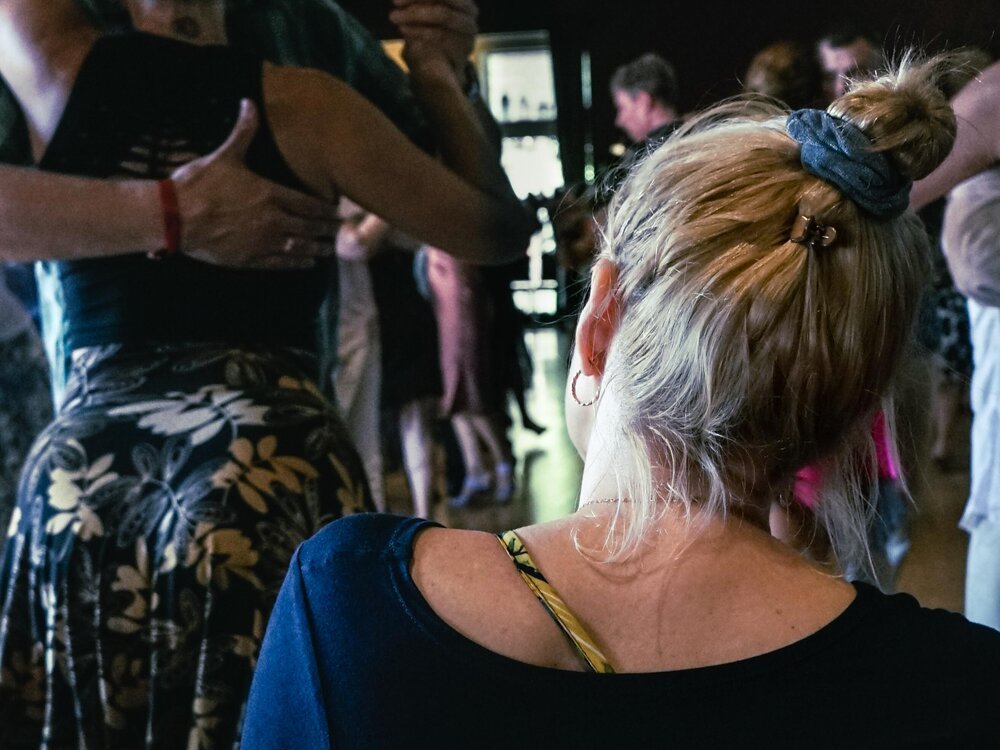5 things to do at the milonga if you’re not dancing
Like life, social dance is pretty unpredictable. Sometimes you go and you barely sit down. Other times you sit for hours waiting wondering if you wore the right thing or if there is something on your face. I am specifically talking about followers here (leaders have their own challenges and deserve a separate blog post). In those instances, what do you do?
I can tell you from experience here is what you DON’T want to do…
You don’t want to sit and ruminate, complaining in your head about whatever might be in the way of your having a good time.
Well, I take it back, you COULD do that, but it is practically guaranteed to make you feel worse and take you even further from where you want to be. Nobody is going to rescue you from those feelings. And if they do, it’s an exception to the rule.
Typically, people can feel this kind of thing from a mile away. Fear and negativity reflect back with exponential force at a milonga. I learned that the hard way in Buenos Aires. If I went into a milonga feeling crabby (or badgery I call it), I ALWAYS had a bad night. If I didn’t, it was because somewhere along the way I was able to change my attitude and put my inner badger to rest. Eventually, if I could tell that I was in a really bad mood and there was no way for me to get into a different state of mind I would decide not to go out at all but go to bed instead.
So anyway, if you are not dancing there is a number of things you can do to either a) help you get more dances b) have a good time regardless.
Chat up other women - getting to know other women is the best investment of time you could make at the milonga if you’re not dancing. You develop friendships, get advice, and you inadvertently will get introduced to other dancers who will invite you to dance. Tango dancers are like cats - finicky and unpredictable - so sometimes a simple introduction from another dancer is all it takes to get that dance you have been trying to get.
Find a different place to sit - so often, as followers, we pick one corner of the room and stay there the whole night. Every space is different and that influences how people move through it, where the cabeceos are happening, where people become invisible. One time at La Viruta (a busy Milonga in Buenos Aires) I decided to “rest” and hide by sitting near the men’s bathroom. Little did I know that this was the hottest spot in the room for cabeceo because as men left the bathroom they would see me sitting there looking pretty and all. I scored many a dance from that spot. Changing your place also helps you meet and talk with new people which will keep your dance night feeling fresh and interesting.
Just walk around! This one I had to learn as a leader. If I don’t like where I’m sitting and I don’t see another place where I want to be, I walk around. I go to the bathroom, I go see who is outside (frequently there will be some people taking a break outside and that way I have the opportunity to just talk to people without the pressure of dancing). Go to the bathroom, walk over to the snack table. (This is also a good strategy to avoid dances that you might not want (if the leader is not following the cabeceo etiquette and heading towards you to ask for a dance. Instead of having to say no outright, just walk somewhere else before they get to you. The timing has to be right but overall it’s subtle and convenient.)
Speaking of the snack table! Always a good spot to check out for cabeceo, especially in-between tandas. And if you are not being asked to dance, well you can just hang out and enjoy some snacks and chat with other people.
Go chat with the DJ - if I am not dancing and there is nobody to chat with, I frequently will go say hello to the DJ and talk to them about their music. This is a great opportunity to ask what music is playing, or what’s coming up next. You get to chat AND get a little bit of learning accomplished! I am all about efficiency. Caution! I have to warn you, some DJs don’t like people talking to them while they are working, so you kind of have to observe and decide in the moment. But hardly any DJ would mind hearing a compliment and answering a question about the music. You can start with that, and then see if they are open to talking or they have their reclusive vibe on.
A milonga is a social event first, a dance experience second. So as social creatures we will always be negotiating our place at each event. We will practice our social skills, our ability to strike up casual conversations, ask good questions, formulate genuine compliments - all of that in addition to the actual tango dance!
So the next time you find yourself feeling bored at a milonga, try one of these other strategies on for size and see if that inspires some new experiences for you.

